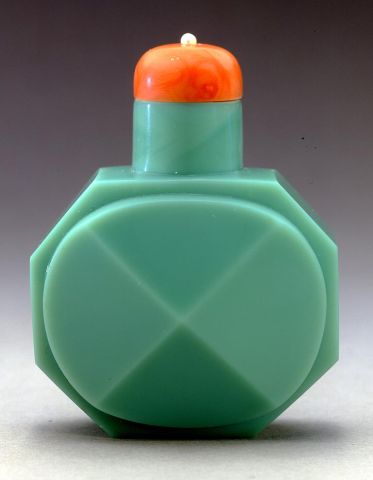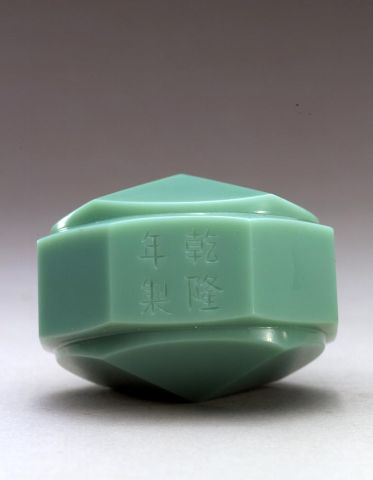

Bottle ID: 00410
TURQUOISE, OCTAGONAL FACETED W/RAISED PANELS
Date: 1750-1795
Height: 52 mm
Glass, of octagonal faceted form with raised panels on the front and reverse, blown and carved as diagonally segmented quatrefoils, the straight neck ending in a wide mouth, of opaque turquoise tone, the base with a four character Qianlong nianzhi mark and of the period.
Imperial, attributed to the Palace Workshops, Beijing.
Similar Examples:
Crane Collection nos. 271 and 498.
Crane Collection no. 296
Snuff Bottles of The Ch'ing Dynasty: Catalogue of an Exhibition at the Hong Kong Museum of Art, 1978, p. 71, no. 5.
Provenance:
Asian Art Studio
Exhibited:
Annual Convention ICSBS Toronto, October 2007
Identifying individual pieces of glass according to their accompanying reign mark can be a dangerous occupation. However, there are certain characteristics which can be attributed to specific periods. During the initial years of glass production, in the reigns of Kangxi and Yongzheng, new colors were quickly added to the repertoire of the glass-makers. These included clear glass, white, translucent blue, yellow, and of course, a highly appreciated ruby-red. By the Qianlong period, additional colors included the opaque turquoise of this example. The Chinese had a penchant for imitation and it is likely that this color was developed to resemble the semi-soft stone, turquoise. A small rounded turquoise bottle with an authentic Yongzheng mark is in the Collection of Suzanne Ault of England, perhaps providing the precursor to a bottle in glass such as this one. Faceting itself is thought to have derived from European objects which appeared in the Palace at this time. Although influenced by the West, the technique of faceting in this case is clearly Chinese. This snuff bottle would have been mold-blown, then cut and polished in a similar way to the method used by the jade carvers of the time, a number of whom were present in the glass workshops. A liking for this style continued through the eighteenth century and into the Daoguang period with bottles generally getting larger in size as time went on.
< Back to full list
 English
English 中文
中文